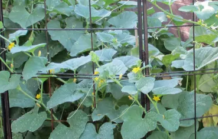IN THE GARDEN for July 2015 by Christina Hoyt, Nebraska Statewide Arboretum There aren’t many years in Nebraska when “plants for wet sites” is the hot topic. But May 2015 brought 11 inches of rain to the Lincoln area—exposing some low, wet areas we didn’t even know existed. With Nebraska’s weather extremes, however, wet sites don’t stay wet for long. The plants we choose for these locations need to be able to tolerate periods of wet feet as well as periods of drought… quite a challenge for the gardener. The type of wet conditions also varies. A wet, poorly drained site is different than a moist site with good drainage. Wet soils have low oxygen content since the pore space is full of water. For most plants good root growth requires a careful balance of moisture and oxygen; and many plants that like moisture cannot handle standing water. Below are some plants that can tolerate wet soil. Buttonbush, Cephalanthus occidentalis, can take standing water and wetland conditions but is also fairly drought-tolerant so it’s a good plant for areas where seasonal moisture varies. It grows to 10 feet, has showy white blossoms and is a great larval host for butterflies. Silky or swamp dogwood, Cornus amomum, grows about 10 feet high and likes wet to moist soils. Flat-topped flower clusters May to June give way to beautiful blue berries in late summer. Summersweet, Clethera alnifolia, can handle standing water for short periods and is sensitive to drought. It has very fragrant flowers mid-summer that give way to persistent seed capsules. It grows 4-8 feet high. Fothergilla likes moisture but needs good drainage and is fairly drought-tolerant once established. It has brush- like white flowers in early spring and good fall color. It grows to 6 feet and a dwarf version to 3 feet. Sweetspire, Itea virginica, grows 3-5 feet high, likes moisture, prefers good drainage and can take shady conditions. It has fragrant flowers in June and July; leaves turn red in fall and persist into December. Winterberry, Ilex verticulata, can tolerate periods of standing water. It’s a wetland plant grown for bright red barriers in fall and winter. Both male and female plants are necessary for pollination and berry production. Joe pyeweed, Eupatorium maculatum, is a butterfly favorite that loves moist soils and can tolerate short periods of flooding, but prefers good drainage. Swamp milkweed, Asclepias, is a larval host for monarch and swallowtail butterflies and attractive to bees. It provides a showy display of rose-pink flowers in summer months. It prefers moisture but doesn’t like standing water and can grow to 4 feet. Queen-of-the-prairie, Filipendula, prefers full sun and moist to wet soils. It can grow 5 feet high with showy flower plumes; a show stopper for the back border that can be aggressive. Meadow blazing star, Liatris ligulistylis, is another great butterfly plant with purple flowers in late summer. Tolerates wet soil in sun or part shade, reaching 5 feet high in rich soils. It’s a “wet-mesic” plant adapted to moist conditions in spring and a drier late season. Turtlehead, Chelone glabra, grows 4-5 feet high in part shade or sun. A wonderful late-bloomer, its deep green foliage and bright blossoms don’t fade in late summer heat. Sneezeweed, Helenium autumnale, is a late summer bloomer with yellow to rust-colored daisy-like blooms. False sunflower, Boltonia asteroides, has finely cut foliage and clouds of small, daisy-like flowers in late summer. This pollinator plant for wet or dry soil can grow 4-6 feet high. Many of the sedges and rushes can handle long periods of standing water and they come in a wide range of sizes and ornamental characteristics. Shrubs (many of these tend to form thickets) Perennials




